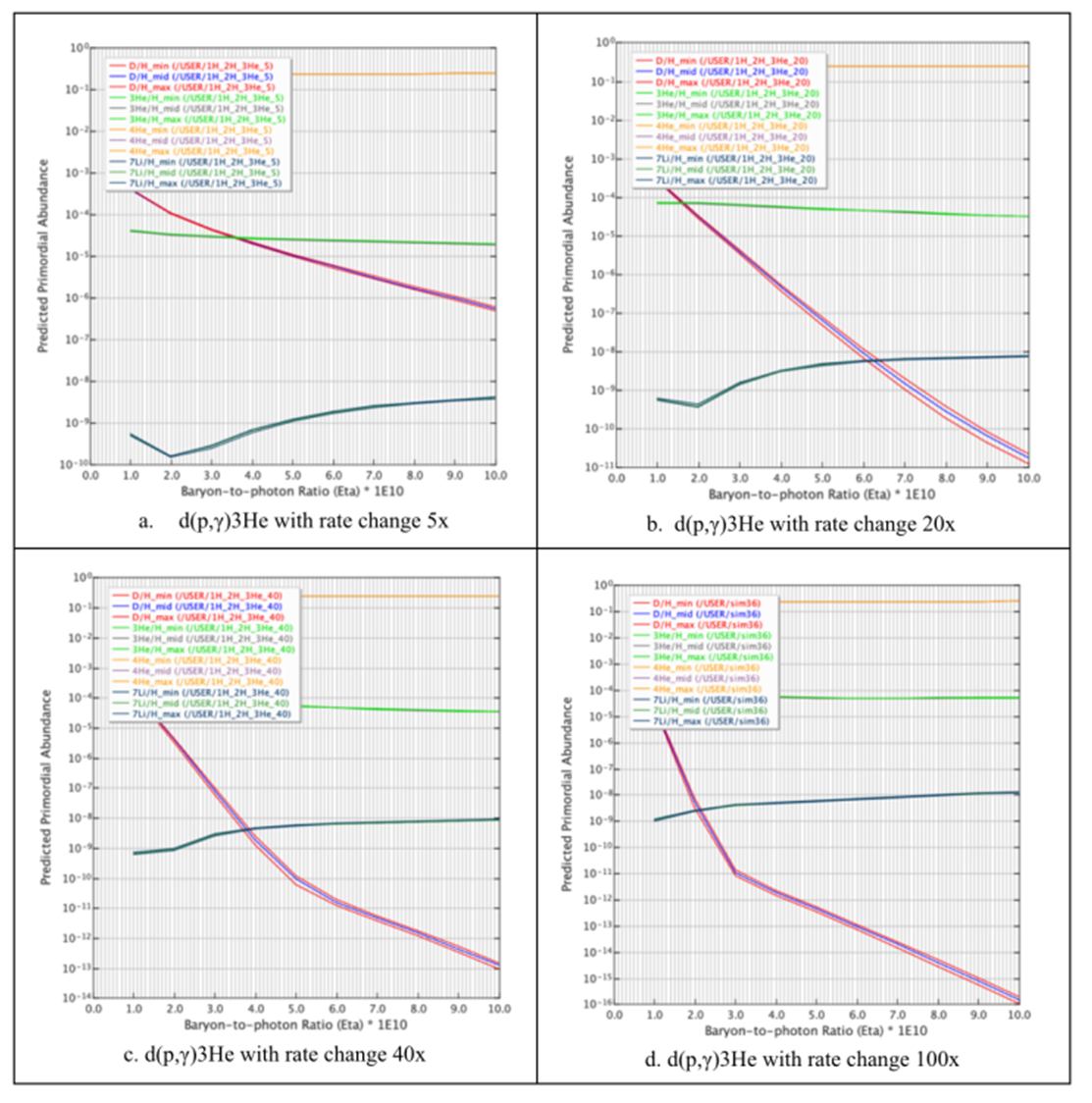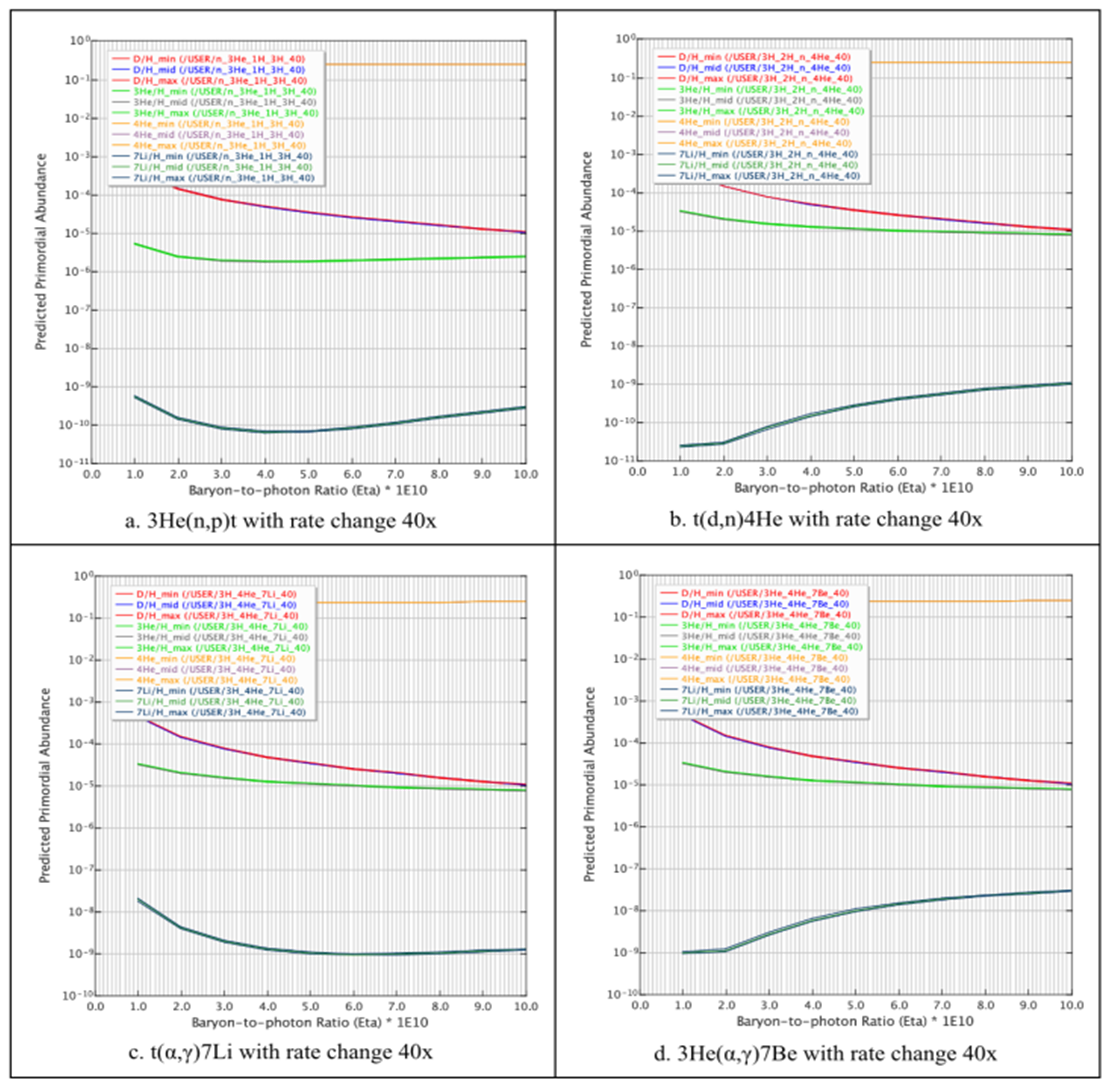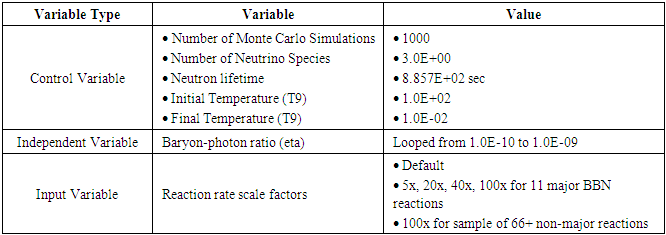-
Paper Information
- Paper Submission
-
Journal Information
- About This Journal
- Editorial Board
- Current Issue
- Archive
- Author Guidelines
- Contact Us
International Journal of Theoretical and Mathematical Physics
p-ISSN: 2167-6844 e-ISSN: 2167-6852
2019; 9(1): 1-8
doi:10.5923/j.ijtmp.20190901.01

Big-Bang Nucleosynthesis Reaction Rate Change Sensitivity Analysis
Niranjan Bhatia
Monta Vista High School, Cupertino, CA, USA
Correspondence to: Niranjan Bhatia, Monta Vista High School, Cupertino, CA, USA.
| Email: |  |
Copyright © 2019 The Author(s). Published by Scientific & Academic Publishing.
This work is licensed under the Creative Commons Attribution International License (CC BY).
http://creativecommons.org/licenses/by/4.0/

Primordial Big-Bang Nucleosynthesis (BBN) took place roughly three minutes after the big-bang and lasted for approximately 17 minutes. Light elements [D, 3He, 4He, 6Li, and 7Li] could be formed since the temperature was so high for nuclear fusion to happen. The primordial light elements abundance is related to many parameters including the thermonuclear reaction rates, temperature, baryon-to-photon ratio, and fundamental constants (e.g. gravitational constant). There are more than 88 thermonuclear reactions during the BBN out of which impact in light element abundance from rate variations is typically observed only from the 12 major BBN reactions. Variations in abundance of D/H, 3He, 7Li vary more with rate change in the reactions they are sensitive to. 4He has little sensitivity to rate variations. In this project, I am trying to analyze sensitivity of variations in primordial light element abundance to reaction rate changes using a BBN simulation software. My hypothesis is that for a particular eta value, most of variations noted in light element abundance will be due to rate scaling and slope of abundance curves over eta (due to rate changes) are expected to vary within a certain factor (10+/-2). My conclusions closely supported the hypothesis for all reactions except change in abundance of D/H in reaction d(p,γ)3He which needs further research from a nuclear physics perspective. D/H abundance change magnified with a combination of rate and eta increase. As the rate was scaled higher, steepness of D/H abundance slope increased with an increase in eta.
Keywords: Big bang nucleosynthesis, Astrophysics, Cosmology, Primordial light element abundance, Thermonuclear rates, Monte carlo simulation, D/H, 3He, 4He, 7Li, Baryon-photon ratio
Cite this paper: Niranjan Bhatia, Big-Bang Nucleosynthesis Reaction Rate Change Sensitivity Analysis, International Journal of Theoretical and Mathematical Physics, Vol. 9 No. 1, 2019, pp. 1-8. doi: 10.5923/j.ijtmp.20190901.01.
Article Outline
1. Introduction
1.1. Background
- Nucleosynthesis is the process which which atomic nuclei heavier than the Hydrogen atom is produced from simple nuclei by chemical reactions. A simple example is the p(n,γ)d reaction in which p and n are fused to for deuterium and emit gamma radiation:
 | (1) |
1.2. Model Parameters
- Eta is a free parameter in the standard BBN model, that is, it’s value is not predefined but is chosen or adjusted. All the abundances change with eta. Hence, it is an independent variable in our simulations because its value is changed by the system while running the different iterations of the simulations. The reaction rates are input variables into the model. Once the reaction rates are input for certain reactions, they cannot be modified by the system between the different iterations. To modify the rates, the rate would need to be re-entered and the simulations would need to be re-executed. Since eta is independent variable and reaction rate the input, variations will be noted from both [8]. Hence, in this project we modify the reaction rates which is the model input parameter with eta being the independent variable and observe changes in the abundance which is the dependent variable or output.
1.3. Hypothesis
- In this project, I am trying to analyze sensitivity of variations in primordial light element abundance to reaction rate changes using a BBN simulation software. My hypothesis is that for a particular eta value, most of variations noted in light element abundance will be due to rate scaling and slope of abundance curves over eta (due to rate changes) are expected to vary within a certain factor (10+/-2) [7].
2. Materials & Methods
2.1. Project Methods
- My general project methods are computational simulation, sensitivity study, and what-if scenario analysis.
2.2. Software
- Bigbangonline.org (Kawano code engine) BBN simulation software was used for the project since its features are perfectly compatible with the project goals. It takes thermonuclear reaction rates as inputs, runs simulations, and produces the predictions of light element abundances. Its engine runs in the cloud. The only software installation needed to run it is a light-weight interface.
2.3. Model Variables
- The model input variable was the thermonuclear reaction rate which was varied for 11 of the 12 major BBN thermonuclear reactions. Sample of other 66 non-major reactions are taken. The independent variable was the baryon-photon ratio. The baryon–photon ratio is a key parameter determining the primordial light element abundance. The control variables were reactions, nuclides, fundamental constants (including the gravitational constant and cosmological constant), the neutron lifetime, number of neutrino species, and the temperature. The dependent variable was the final predicted primordial light element abundances. The primordial light element abundance is the measure of the present quantity of the light elements D, 3He, 4He, and 7Li from the Big Bang. The standard BBN model makes predictions of light element abundances formed very early in the Universe, with one free parameter (baryon-photon ratio or eta). These are compared to observations made today, and the values of eta are found that give consistency between predictions and observations. Light elements were produced during the BBN, while elements heavier than helium were formed due to stellar nucleosynthesis which occurred much later.
2.4. Process
- The BBN simulation software used can be downloaded and launched from http://www.bigbangonline.org/. The reaction rates can be modified in the menu option “Nuclear Reaction Rates and Rate Libraries” -> “Rate Manager”. The BBN simulations can be performed by selecting the appropriate thermonuclear reaction rate for the reaction and setting the values of the parameters including “Computational Parameters”, “Early Universe Parameters”, “Looping Parameters”, and number of trials in the Monte Carlo Simulation.Once the simulations are complete, the simulation results can be visualized by clicking on the option “Final Abundance Plotting Interface” and seeing the details on the primordial abundances of the light elements. The results can be reviewed and compared to the results with default parameter values to determine variations in the abundance of the light elements. The whole process can be repeated by modifying different reaction rates as well as creating a new rate.
3. Results
- The simulation variable values were as follows:
|
 | Figure 1. Abundance plot with default parameter values |
 | Figure 2. Abundance plot with rates changes 5x, 20x, 40x, 100x for d(p,γ)3He |
 | Figure 3. Abundance plots with rate change 40x for d(d,n)3He, 3He(d,p)4He, d(d,p)t, & p(n,γ)d |
 | Figure 4. Abundance plot with rate change 40x for 3He(n,p)t, t(d,n)4He, t(α,γ)7Li, & 3He(α,γ)7Be |
 | Figure 5. Abundance plot with rate change 40x for 7Li(p,α)4He & 7Be(n,p)7Li |
|
4. Discussion
- As expected, variations in light element abundance were noted when rates of all 11 major reactions were modified.For D/H abundance, changes were observed in 4 reactions: d(p,γ)3He, d(d,n)3He, d(d,p)t, p(n,γ)d. Abundance results for 3 reactions d(d,n)3He, d(d,p)t, and p(n,γ)d changed by factor 10+/-2 with rate increase. The fourth reaction, d(p,γ)3He, showed a steep decline in D/H slope with eta with rate change increase. The change in abundance magnified with a combination of rate and eta increase. For eta 2.0, the abundance varied by a factor of 10-4 with rate. But for eta 10.0, it varied by a factor of 10-10 with rate. As rate was scaled higher, the steepness of slope of D/H abundance increased with eta until a certain value, and then decreased. With increase in rate, the value of eta at which steepness decreased also decreased.For 3He abundance, as expected, fractional change with rate variations was noted in the five reactions: 3He(d,p)4He, d(d,p)t, 3He(n,p)t, d(p,γ)3He, and d(d,n)3He. For 7Li abundance, marginal change was observed with rate variations in 7Li abundance in two major reactions. Greater fractional impact (within a factor of 10+-2) was observed in nine of 11 reactions. For 4He abundance, as expected, there was no impact to 4He abundance (see research section for details).Overall, the results of all reactions except d(p,γ)3He supported the hypothesis, viz., the slope of abundance curves over eta changed by factor within 10+/-2 and variations noted for a particular eta value were due to rate change. The exception noted was D/H abundance in reaction d(p,γ)3He. For this reaction, the rate variations increased with an increase in eta and the magnitude of change was much greater than the factor of 10+/-2 (from 10-4 with eta 2.0 to 10-10 for eta 10.0). As rate was scaled higher, D/H abundance sharply declined with increase in eta. Hence, the D/H abundance shows sensitivity to a combination of rate change as well as eta. Hence, the results support the hypothesis for all reactions except D/H abundance for reaction d(p,γ)3He which needs further investigation from nuclear physics perspective.However, there are limitations. The simulation is only a tool which codifies our knowledge of the process of formation of light elements, takes input variable values, and produces output. BBN abundance depends on other factors including fundamental constants and expansion rate. To get a holistic picture, other factors also need to be explored. In this simulation, one independent variable, baryon-photon ratio (eta), was modified. Since reactions are dependent on multiple variables, impact of modifying other variables like temperature and fundamental constants also needs to be accounted for.Accurate knowledge of reaction rates is important in nuclear astrophysics for understanding energy generation. My work will help to understanding rate change impacts to guide future nuclear physics measurements. My work has certainly inspired me to ask more questions about impact of other factors on BBN including fundamental constants, magnetic fields, and dark matter.
ACKNOWLEDGEMENTS
- I wish to thank my physics teacher at Monta Vista High School, Mr. Jim Birdsong, for helping me and keeping me motivated to complete this research work which was submitted to the Google Science Fair in 2018.
 Abstract
Abstract Reference
Reference Full-Text PDF
Full-Text PDF Full-text HTML
Full-text HTML
